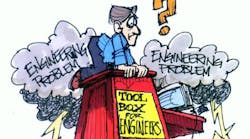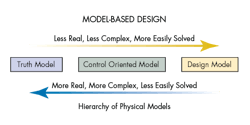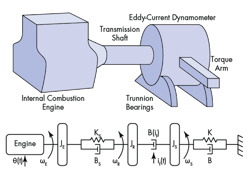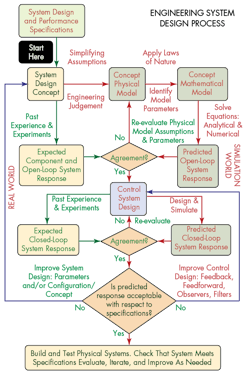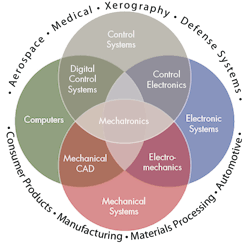Engineering companies and their engineers are each facing an innovation crisis. “Innovate or Perish” is the mantra often heard, but how can innovation happen when they are each facing a real dilemma? As an engineering educator, researcher, and consultant, I have worked with over two dozen companies over the past 25 years. I have heard the following grave concern expressed more and more often by company executives:
“Our senior engineers with experience and integrated know-how are retiring and taking with them our core competencies. The new engineers have no multidisciplinary, integrating, systems experience. Academia does not teach that! We are losing our competitive advantage! How can we capture that engineering expertise and enhance our engineering workforce to keep our competitive advantage? Should we send one or two engineers to graduate school for a M.S. degree? That usually consists of 10 courses, or 8 courses plus a project, with little integration, no applications, all theory, and no practice. And the cost and time commitment are very high. These engineers still need to work full time and they have families. So that is not the answer. There has to be a more effective way to enhance our work force with immediate results. We need help.”
Focusing on Multidisciplinary Engineering
The solution to these two dilemmas is a renewed focus on multidisciplinary, model-based, systems engineering and a paradigm shift in the way education for the practicing engineer is delivered. Through model-based design, companies can formally document and protect their core competencies and their engineers can tackle any multidisciplinary systems problem that comes along.
So what actually is model-based design and why is it the key to multidisciplinary engineering practice? A physical model of a design concept, based on simplifying assumptions (which change as the project progresses and one learns better what effects matter more than others), is created. This approximates the real system and a hierarchy of models is possible depending on the reason for modeling.
The laws of nature (e.g., Newton’s Laws, Maxwell’s Equations) are applied to the model, along with component model equations, to generate the equations of motion for the multidisciplinary engineering system. A simulation program solves these equations—nonlinear and coupled—to predict how the model will behave when various inputs—desired and disturbance—are applied. Experience or experimental testing verifies these predictions. A control system is then designed based on this system model. Simulating the controlled system then verifies the predictions. At that point, changes can be made either to the system design or to the control design, as nothing has been built yet. Once a design—system plus control—meets the performance requirements, then assumptions can be relaxed and parasitic effects can be added to bring the model as close to reality as possible. Response and actuation plots are the deliverables, along with model equations and the accompanying block diagrams. If this is not done, then the only alternative is to take the concept, which existed only in animation form with no substance, and build it hoping for the best.
How does one create this system without modeling? The only answer is to build it and see if it works. If one has done this before and has a lot of experience, maybe that approach will be successful. But if something happens that is not understood or there is a need to improve the performance of the system, there is no way to do that other than by trial and error and that leads to huge cost, lots of time, and still no understanding. In the end, the deliverable is a working system along with a complete understanding of how the system works, so in the future it can be improved with minimal effort because one already understands how it works.
Teaching Physical Modeling: Art or Science?
Many engineers have little experience, and, hence, little confidence in doing physical modeling. Physical system modeling, either applied to an existing system or a concept in the design process, leads to thorough understanding, differentiates engineers, and gives companies a competitive advantage as it leads to innovation.
Often, engineers refer to modeling as mathematical modeling. That is misleading. One obtains a mathematical model by applying the laws of nature to the physical model, not to the physical system. The physical model must come first, and, as the image above shows, there is a hierarchy of physical models possible in response to the question: “Why am I modeling?”
Engineering judgment and simplifying assumptions applied to the physical system lead to the physical model, which must capture the essential multidisciplinary attributes of the physical system. Hence, a working knowledge of multidisciplinary physics is essential. Always, the simplest model that meets the need is best. It is the modeling skills of the engineer that need to be enhanced, not the use of modeling tools.
The images above show an internal combustion engine connected to an eddy-current dynamometer. The engine is considered a nonlinear angular velocity source (ωE) modulated by the throttle setting θ (t). The main energy storage is associated with the rotating inertia JE, lumped at the output of the engine shaft. The torque transmission shaft has compliance and energy dissipation, and is modeled with a rotational spring KS and rotational damper BS. The shaft inertia is neglected. The dynamometer consists of a toothed rotor JR which rotates (ωR) in the magnetic field created by passing current if (t) through the stator windings. A voltage is induced in the conductive rotor rotating in the stator magnetic field (Faraday’s Law). This induced voltage creates eddy currents in the rotor which generate a magnetic field (Ampere’s Law) which opposes the stator magnetic field (Lenz’s Law). The stator inertia JS, mounted in trunnion bearings, is free to rotate, but is restrained by a torque arm to measure the torque developed. The spring K and damper B represent the compliance and energy dissipation associated with the torque measurement. So successful physical modeling requires a fundamental understanding of multidisciplinary physics and a commitment to do it and not fall back on the old design-build-test approach. This is the most direct path to innovation.
Modernizing Engineering Education
Let us now turn to education and start with an analogy. If a young person wants to be a complete baseball player, he must be able to field, throw, run the bases, hit with power, and all these skills must be applied in an actual baseball game. To achieve this goal, he learns all these skills at the same time, improving gradually in each one while playing actual games and, over time, develops into a complete baseball player. The result is more than just the sum of the skills learned, but a sense of confidence and savvy that makes him a winner.
In multidisciplinary engineering practice, a model-based design approach is essential and the necessary skill set includes modeling and analysis of multidisciplinary dynamic engineering systems, including their digital control systems and their sensors and actuators with the necessary electronics. Theory and practice must be in balance when mastering these skills. It rarely happens in engineering that one can combine the two (i.e., “playing the game”) either virtually in a computer simulation or physically with an actual hardware system to create a system to solve a problem. We devote separate courses to each skill and somehow think that learning each skill very well will somehow magically enable the student to graduate and critically think, integrate it all, and solve a real-world problem. In the baseball analogy, this would be utter madness, yet in engineering education, it is routine.
The present situation then is that engineering education today is ineffective in preparing students for multidisciplinary, model-based system integration and optimization which is exactly what is needed by companies to become innovative and gain a competitive advantage in this global economy. While there is some movement in engineering education to change that, this change is not easy, as it involves a cultural change from the silo approach to a holistic approach. I have heard it said that is easier to move a cemetery than it is to change an engineering curriculum. Engineering schools for whom that is true might soon be buried in those cemeteries. If all engineering schools do is deliver information, i.e., traditional course content in a lecture format, then those schools will cease to exist, as there is little impact on student learning and performance with that type of education. The senior capstone multidisciplinary design course, for example, too often becomes a design-build-test exercise with the emphasis on just getting something done. Students rarely break out of their disciplinary comfort zone and thus fail to experience true multidisciplinary system, model-based design. What is needed are model-based design activities, with a balance between theory and practice, between academic rigor and the best practices of industry, presented in an integrated way throughout the engineering curriculum that prepares students for true multidisciplinary system, model-based engineering at the senior level and beyond.
The top two drivers in industry today for improving development processes are shorter product-development schedules and increased customer demand for better-performing products. As engineering systems are becoming ever more multidisciplinary and complex, can these two goals be achieved at the same time? Challenges inhibiting product development fall into two categories: the multi-domain nature of the complete system and integration of the domains, and finding errors early in the development cycle and testing before hardware is available. Once a system is in development, correcting a problem will cost 10 times as much as it would to fix the same problem in concept. If the system has been released, it costs 100 times as much.
Engineering System Design Process
The Engineering System Design Process addresses these challenges. Through system modeling and simulation, it facilitates: understanding the behavior of the proposed system concept; optimizing the system design parameters; developing optimal control algorithms, both local and supervisory; testing control algorithms under various scenarios; and qualifying the production controller with a simulated version of the plant running in real time (hardware-in-the-loop testing), before connecting it to the real plant. The Engineering System Design Process provides an environment with numerical and graphical analysis and design tools that stimulate innovation and cooperation within design teams. It aims to reduce the risk of not meeting the functional requirements by enabling early and continuous verification throughout the entire design workflow.
The overarching theme in all engineering courses should be human-centered, model-based, multidisciplinary engineering problem solving. In engineering design, a poorly designed physical system will never be able to give outstanding performance by adding a sophisticated controller. Similarly, traditional course content, even if delivered on line by the best lecturers in the world, is still just information, a commodity. The problem is not the delivery method; the problem is the content of the delivery. Engineering content must be re-bundled and integrated with a balance between theory and industry best practice. That information then becomes knowledge that is not a commodity. It is this knowledge that stimulates students and transforms them into critical-thinking problem solvers resulting in a real competitive advantage in this global economy. So while the challenges for engineering education are being talked about everywhere, the only way they will be solved is by changing culture—attitude and behavior—rejecting silos and comfort zones, and instilling ownership. Until engineering education is viewed as an equal partner with engineering research in achieving innovation, this will not happen.
The word “mechatronics” was created in the 1970s to describe the integration of mechanisms and electronics in consumer products. It evolved in the 1990s into the creation of smart products through the integration of microprocessors and electronics into traditional mechanical systems. It now has come to mean multidisciplinary engineering system design, with the synergistic integration of sensors, actuators, electronics, and real-time computer control with the multidisciplinary system occurring at the very start of the design process—no afterthought add-ons allowed—thus enabling complex decision making. Mechatronics is multidisciplinary systems engineering method for the modern education system.
The most important attributes of mechatronics are balance between theory and practice and between academic rigor and best industry practices, with hands-on, real-world case studies, and human-centered, model-based design showing the integration of mathematics, physics, and multidisciplinary engineering from the very start of the design process. These attributes cannot be achieved by simply selecting from a list of existing courses but through a re-bundling and integration of content, delivery, and hands-on activities. The department silo structure that persists at universities, the emphasis on research above education, and the tolerance of faculty comfort zones make this ideal impossible. Creating and delivering a true mechatronics program requires a level of effort and expertise that is presently unattainable at a university, mainly because there is no reward system in academia for this. At a university, it has been, and always will be, about funding and publications. Traditional university-based engineering education will not change until it is on the verge of becoming irrelevant, and that time is rapidly approaching. Of course, there are exceptions to my statements, but they are scarce.
The best mechatronics preparation is a mechanical engineering program with several elective electronics, controls, and embedded-microprocessor courses. Many top engineering schools have an undergraduate mechatronics course or a sequence of mechatronics-type courses (e.g., controls, sensors and actuators, and mechatronic system design) during the last three semesters. An entire four-year mechatronics program is not necessary. Mechatronics graduate programs do exist, either on campus or on line. In 2016, the NYU Tandon School of Engineering launched the M.S. Program in Mechatronics and Robotics, with a long-term expectation of 40 graduates per year. This is a traditional 30-credit (8 courses and a 6-credit project) on-campus program. NJIT’s Electrical Engineering Department has a M.S. degree with a specialization in Mechatronics. It is entirely on line and consists of 10 three-credit courses focusing mostly on control systems. The Johannes Kepler University in Linz, Austria, offers a Master’s Degree in Mechatronics. It is an on-campus, 4-semester program combining mechanical engineering, electronic engineering, and informatics. Finally, Hofstra University School of Engineering and Applied Science Center will offer a newly-created Mechatronics Certificate Program for Practicing Engineers starting June 1, 2016.
The goal is to empower practicing engineers to significantly elevate their skill level with immediate tangible results to compete in the global economy. As traditional engineering skills and information are commodities today, this program is designed to exceed fundamental skills, with an integration of rigorous theory and best industry practice, to enhance engineering practice for companies competing to solve society’s most urgent problems, and for engineers presently working in the trenches. Human-centered, model-based multidisciplinary design, grounded in mathematics and physics, is the key.
Using Hofstra University’s Mechatronics Certificate Program for Practicing Engineers as an example, some of the multidisciplinary courses that offered are:
- Physical and Mathematical Multidisciplinary Energy-Based Modeling
- Electrical Systems & Electronics for Power, Sensing, and Control
- Mechanical Systems: 2D and 3D Dynamics, Mechanical System Components
- Fluid Systems: Fluid Power Electro-Hydraulic Systems and Electro-Pneumatic Systems
- Computer Simulation: MatLab, Simulink, SimHydraulics, SimMechanics, SimElectronics
- Control System Fundamentals, including Programmable Logic Controllers
Engineers will learn the basic building blocks which comprise 21st-century multidisciplinary engineering systems, with a balance between academic rigor and best industry practices, and learn to integrate them into complete multidisciplinary engineering systems through various real-world case studies. They will experience the application of what they have learned in the formal modules to actual hardware systems at the end of each module in the Mechatronics Lab. Companies will benefit by having an empowered mechatronics engineer who can serve as a catalyst for change and a mentor to other engineers.
